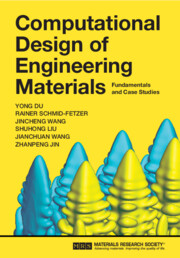Refine search
Actions for selected content:
106069 results in Materials Science
What are the fundamental software abstractions for designing reliable cyber-physical systems operating in uncertain environments?
-
- Journal:
- Research Directions: Cyber-Physical Systems / Volume 1 / 2023
- Published online by Cambridge University Press:
- 24 July 2023, e4
-
- Article
-
- You have access
- Open access
- HTML
- Export citation
Synchrotron powder diffraction data for some smectite clay mineral standards
-
- Journal:
- Powder Diffraction / Volume 38 / Issue 3 / September 2023
- Published online by Cambridge University Press:
- 24 July 2023, pp. 224-230
-
- Article
- Export citation
Crystal structure and X-ray powder diffraction data of barium copper iodate Ba2Cu(IO3)6
-
- Journal:
- Powder Diffraction / Volume 38 / Issue 3 / September 2023
- Published online by Cambridge University Press:
- 20 July 2023, pp. 220-223
-
- Article
- Export citation
Prototyping an additive co-fabrication workflow for architecture: utilizing cyanobacterial MICP in robotic deposition
-
- Journal:
- Research Directions: Biotechnology Design / Volume 1 / 2023
- Published online by Cambridge University Press:
- 19 July 2023, e12
-
- Article
-
- You have access
- Open access
- HTML
- Export citation
What is the art of biosecurity?
-
- Journal:
- Research Directions: Biotechnology Design / Volume 1 / 2023
- Published online by Cambridge University Press:
- 13 July 2023, e11
-
- Article
-
- You have access
- Open access
- HTML
- Export citation
PDJ volume 38 issue 2 Cover and Front matter
-
- Journal:
- Powder Diffraction / Volume 38 / Issue 2 / June 2023
- Published online by Cambridge University Press:
- 06 July 2023, pp. f1-f7
-
- Article
-
- You have access
- Export citation
PDJ volume 38 issue 2 Cover and Back matter
-
- Journal:
- Powder Diffraction / Volume 38 / Issue 2 / June 2023
- Published online by Cambridge University Press:
- 06 July 2023, p. b1
-
- Article
-
- You have access
- Export citation
Calendar of Short Courses and Workshops
-
- Journal:
- Powder Diffraction / Volume 38 / Issue 2 / June 2023
- Published online by Cambridge University Press:
- 06 July 2023, p. 165
-
- Article
-
- You have access
- HTML
- Export citation
Calendar of Forthcoming Meetings
-
- Journal:
- Powder Diffraction / Volume 38 / Issue 2 / June 2023
- Published online by Cambridge University Press:
- 06 July 2023, p. 164
-
- Article
-
- You have access
- HTML
- Export citation
How do we engineer trustworthy digital twins?
-
- Journal:
- Research Directions: Cyber-Physical Systems / Volume 1 / 2023
- Published online by Cambridge University Press:
- 05 July 2023, e3
-
- Article
-
- You have access
- Open access
- HTML
- Export citation

Computational Design of Engineering Materials
- Fundamentals and Case Studies
-
- Published online:
- 29 June 2023
- Print publication:
- 29 June 2023
5 - Fundamentals of Computational Thermodynamics and the CALPHAD Method
-
- Book:
- Computational Design of Engineering Materials
- Published online:
- 29 June 2023
- Print publication:
- 29 June 2023, pp 113-197
-
- Chapter
- Export citation
10 - Case Studies on Cemented Carbide Design
-
- Book:
- Computational Design of Engineering Materials
- Published online:
- 29 June 2023
- Print publication:
- 29 June 2023, pp 342-369
-
- Chapter
- Export citation
3 - Fundamentals of Mesoscale Simulation Methods
-
- Book:
- Computational Design of Engineering Materials
- Published online:
- 29 June 2023
- Print publication:
- 29 June 2023, pp 46-94
-
- Chapter
- Export citation
Index
-
- Book:
- Computational Design of Engineering Materials
- Published online:
- 29 June 2023
- Print publication:
- 29 June 2023, pp 469-478
-
- Chapter
- Export citation
Preface
-
- Book:
- Computational Design of Engineering Materials
- Published online:
- 29 June 2023
- Print publication:
- 29 June 2023, pp xvii-xviii
-
- Chapter
- Export citation
Appendix A - Ancillary Materials
-
- Book:
- Computational Design of Engineering Materials
- Published online:
- 29 June 2023
- Print publication:
- 29 June 2023, pp 457-460
-
- Chapter
- Export citation
Dedication
-
- Book:
- Computational Design of Engineering Materials
- Published online:
- 29 June 2023
- Print publication:
- 29 June 2023, pp v-vi
-
- Chapter
- Export citation
Contents
-
- Book:
- Computational Design of Engineering Materials
- Published online:
- 29 June 2023
- Print publication:
- 29 June 2023, pp vii-xiv
-
- Chapter
- Export citation
8 - Case Studies on Light Alloy Design
-
- Book:
- Computational Design of Engineering Materials
- Published online:
- 29 June 2023
- Print publication:
- 29 June 2023, pp 295-322
-
- Chapter
- Export citation





